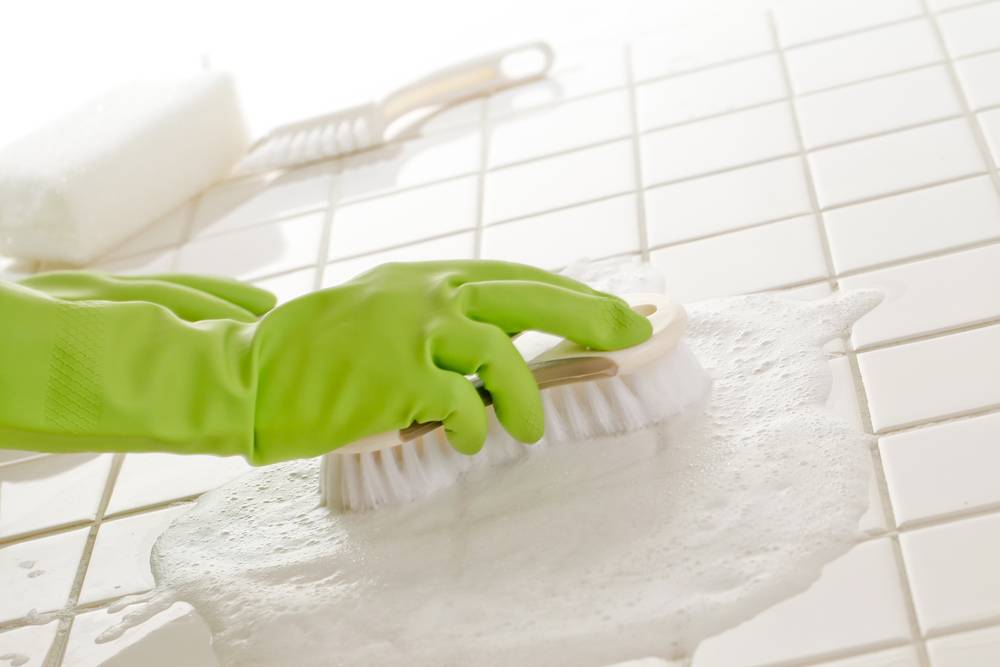With spring around the corner, it is the perfect time to breathe new life into your home. Spring cleaning is more than a tradition; it’s a chance to freshen up your living space and embrace the new season with a clean and organised home.
Now, let’s discuss our room-by-room guide tailored to your Australian home:
Spring Cleaning List for Every Room
Cleaning the Living Areas and Bedrooms
Spring cleaning the living room and lounge area gives these spaces a fresh, inviting feel. These simple steps can transform your living room and lounge area into a clean and comfortable space. It will allow you to enjoy the new season. Here’s our step-by-step guide to deep cleaning so that you can enjoy a cozy and clean living space:
Step 1: Clear Out and Dust
- Remove any clutter, knick-knacks, and decorations.
- Dust all surfaces, including shelves, tables, and electronics.
- Don’t forget to wipe the skirting boards, window sills, doors and frames.
Step 2: Vacuum and Mop
- Vacuum the carpets & rugs, and any upholstered furniture.
- If you have hardwood or tile floors, give them a good mop with a suitable cleaner.
- Make sure to reach under furniture and in corners, where possible.
Step 3: Clean Fabrics and Windows
- Vacuum and wash the curtains and wipe the blinds.
- Clean any fabric-covered furniture with appropriate upholstery cleaner.
- Clean the windows inside and out, including the tracks and fly screens.
Step 4: Care for Delicate materials and surfaces
Taking care of specialised materials requires extra attention, but don’t worry, we’ve got you covered. Here’s how you can care for those unique items in your home:
- Leather Care: Clean, Nourish, and Shine: Begin by gently wiping the leather with a soft cloth slightly dampened with either a leather cleaner or mild soap to remove dirt and grime effectively. Next, nourish the leather by applying a high-quality leather conditioner, which helps maintain its suppleness and prolong its life. Delicately buff the leather with a dry cloth, revealing its natural lustre and beauty. It will help you achieve a stunning shine.
- Marble Care: Preserving Beauty for Decades: Gentle cleaning is essential to ensure the longevity of your marble floors. Swiftly wipe away any spills to prevent staining. Avoid acidic cleaners like vinegar, Windex, and bleach, as they can harm the marble’s delicate surface. Instead, use a pH-neutral cleaner, ensuring cleanliness and marble protection. To maintain its natural shine, treat the surface with a marble-specific polish. With adequate maintenance, your marble floors will continue to enhance your living space for an extended period.
- Caring for Hardwood Floors: Sweep and Mop with Care: Before mopping your hardwood floors, ensure thorough vacuuming to eliminate small particles and debris, preventing potential scratches. Employ a suitable wood floor cleaner and a gentle microfiber cloth during mopping to avoid excessive water, which may harm the floor. Additionally, consider scheduling professional cleaning and buffing once or twice a year. It will help to eliminate scuff marks and minor scratches and restore their stunning appearance. By following these practices, your hardwood floors will maintain their beauty and durability for years.

Spring Cleaning: Kitchen Area and Pantry
The kitchen, the heart of the home, deserves special attention during your spring cleaning. Here’s a step-by-step guide to making your kitchen sparkle and your pantry an organised dream:
Step 1: Cleaning Appliances, Countertops, and Cabinets
- Begin with Cleaning the Small Appliances: Unplug and pull out appliances to clean behind and underneath. Wipe the exterior with a cloth and mild detergent. For the interior, check the manufacturer’s instructions for cleaning guidelines.
- Cleaning the Oven, Fridge and Freezer: Regular deep cleaning is vital for your oven, especially if you cook frequently. Opt for proper chemicals, equipment, and materials, dedicating at least one hour to ensure a thorough cleaning. Professional cleaning might be the best option if you prefer a hassle-free approach.When tackling the fridge, follow these steps for optimal results. Firstly, turn off the fridge or freezer and remove all items from inside. Next, defrost the freezer completely before beginning a thorough cleaning and disinfection process. These steps ensure a clean and hygienic environment for your food storage.
- Cleaning the Range Hood and Stove Tops: The range hood accumulates a substantial amount of dust and grease over time. To clean the stainless steel surface effectively, use a mild detergent while avoiding scrubby or abrasive materials that could cause damage. For a brilliant finish, use a microfiber cloth to polish the surface, restoring its shine. To clean the filters, follow these steps: Remove the filter as per the manual instructions. Then, prepare a cleaning solution by soaking each filter in hot water with half a cup of baking soda and a few tablespoons of dishwashing liquid for 30 minutes. After soaking, gently scrub the filters using a soft brush and rinse them thoroughly. You could follow the same steps to clean the grates from the cooktop. If you need help with how to dismantle it and thoroughly clean all parts, consider calling a professional cleaner.
- Cleaning Kitchen Cabinets, Countertops, Shelving and Backsplash: Start by removing any items or clutter from the cabinets. Dust the exterior and interior surfaces with a microfiber cloth. Mix mild dish soap, baking soda, and warm water for grease or sticky residue. You can wipe the cabinet doors and handles with a soft cloth. Avoid using abrasive materials to protect the cabinet’s finish. Rinse with a damp cotton cloth to remove soap residue. Dry the cabinets with a clean and dry cloth to prevent water spots.
Step 2: Kitchen Floors and Sinks
- Floors: Vacuum and mop the floors with a suitable floor cleaner. Pay attention to corners and under the cabinets. If the grout requires deep cleaning, it’s better to hire a professional tile and grout cleaning service.
- Sinks: Scrub your sink with a mild abrasive cleaner. Don’t forget the faucet and handles.
Step 3: Cleaning and Organising your Pantry for Spring
- Empty: Remove everything from the pantry. Check expiration dates and dispose of the expired items. If you have stocks you can’t consume before the expiry date, you can donate those to your local community and people in need.
- Clean: Wipe down the shelves. If you have pantry bins or containers, clean those too. Soak plastic containers in hot water with vinegar and baking soda to kill germs and bacteria.
- Organise: Put everything back in a way that makes sense. Group your items by type (cans, baking supplies, snacks) or by frequency of use.
Spring Cleaning: Bedrooms and Kids’ Rooms
A clean and organised bedroom is a sanctuary to relax and unwind. On the other hand, kids’ rooms are spaces for creativity and fun.
Follow our cleaning guide to maintain those cozy spaces and welcome spring home.
Step 1: Bedding & Mattresses
- Bedding: Wash all bedding, including sheets, pillowcases, and comforters. Follow the care instructions on the labels.
- Mattresses: Vacuum your mattress and spot-clean any stains. Consider flipping or rotating it if needed.
Step 2: Wardrobes and Drawers
- Declutter: Go through your clothes and accessories. Donate or dispose of items you no longer need or wear.
- Clean: Wipe down the insides of wardrobes and drawers. Consider using drawer organisers for better organisation.
- Organise: Put everything back neatly. You might organize by season, colour, or type of clothing.
Step 3: Dusting, Vacuuming and Windows
- Dusting and Vacuuming: Dust all surfaces, including furniture, shelves, and baseboards. Vacuum the floors, including under the bed and furniture.
- Windows: Clean the windows inside and out. Don’t forget the window sills and blinds.
Step 4: Study and Play Area (for Kids’ Rooms)
- Declutter: Sort through toys, books, and school supplies. Donate or dispose of anything that’s no longer needed or used.
- Organise: Create designated areas for play and study. Use bins, shelves, or containers to keep everything in its place.
- Clean: Wipe down all surfaces, including desks, chairs, and toy storage. Vacuum or mop the floors.
Spring cleaning the bedrooms and kids’ rooms doesn’t have to be a chore. With perseverance and organisation, these spaces can become comfortable and functional areas that reflect your family’s needs and style.

Cleaning the Bathrooms for Spring
Bathrooms are essential spaces in our homes; keeping them clean and fresh is vital for comfort and hygiene. Here’s a step-by-step guide to spring cleaning your bathrooms:
Step 1: Tiles and Grout Cleaning
- Tiles: For cleaning the tiles, use a tile cleaner and scrub by paying attention to corners and edges.
- Grout: If you do not have a grout cleaning solution, try a baking soda paste with water and scrub it with an old toothbrush or a grout brush.
Step 2: Fixtures and Fittings
- Polish: Clean and polish all fixtures and fittings, including taps, handles, and showerheads. Some white vinegar diluted in hot water can have remarkable cleaning effects.
- Check: Inspect for any leaks or loose fittings and fix them if needed.
Step 3: Toilets, Showers, Bathtubs
- Clean the Toilet Bowl: Wipe down the seat, lid, and tank with a toilet brush and cleaner.
- Showers and Bathtubs: Scrub the shower walls, doors, and bathtub with a suitable cleaner. Don’t forget the shower track and drain.
Step 4: Cleaning the Mirrors, Windows, Floors, Towels and Mats
- Mirrors and Windows: Wipe down with a glass cleaner for a streak-free shine.
- Floors: Sweep and mop the floors. Pay attention to corners and the areas behind the toilet.
- Towels and Mats: Wash or replace any old towels and bathmats.
- Declutter: Go through your toiletries and dispose of expired or unused items.
Spring cleaning the bathrooms might seem like a big task. But with a little focus and determination, you can make your bathrooms sparkle.
Also Read This Blog: 11 Expert Cleaning Hacks for Spotless Bathrooms
Spring Cleaning: Household Items and Furniture
Spring cleaning isn’t just about scrubbing and polishing; it’s also an opportunity to reorganise and declutter your home. It allows you to create a more comfortable and efficient environment by letting go of unnecessary items and rearranging your living spaces. Here’s how to get started:
Re-Organise and Replace Furniture
- Evaluate: Look at each room and consider how the furniture arrangement affects flow and function.
- Rearrange: Move furniture to create more open space or make the room more functional for daily activities.
- Update: Consider replacing worn-out furniture that no longer serves your needs
Recycle: Unnecessary Belongings
- Sort: Go through each room and sort items into categories: keep, donate, recycle, or dispose of.
- Donate: Consider donating items in good condition to local charities.
- Dispose: Safely dispose of broken or unusable items according to local regulations.
- Paperwork: Sort through paperwork and create a filing system for important documents. Shred or recycle unnecessary papers.
- Digital Clutter: Consider organising digital files, emails, and photos. Backup important data.
- Seasonal Items: Store seasonal clothing, decorations, or equipment in labelled containers.
Organising and decluttering is a process that can truly transform your home. It’s about making intentional choices and creating spaces that reflect your values and lifestyle.
#ReduceWhatsInYourBin: Think globally and act locally
Inspire behavioural change by starting with your home and leading by example at school or your workplace. Consider joining the various events and initiatives taking place.
The 6R’s of Waste – #KABWeek2023
- REFUSE – Avoid using single-use plastics: Bring your glass water bottle, or use coffee mugs, shopping bags, cutlery and straws made of more sustainable materials.
- ROT – Your organic waste: Master your FOGO bins or composting and keep organics out of landfill. Learn what materials are compostable and precisely investigate what can be placed in your organic waste bin.
- REDUCE – Paper usage and waste: Choose to go paperless. Opt for digital statements, decline printed receipts, and only print on recycled paper when necessary.
- REUSE – Repurpose or repair your fashion items: Buying second-hand clothes or donating old fashion items helps sustain a circular economy. Try to repair your clothes and extend their lifespan or get creative and repurpose them.
- RECYCLE – Your tricky items: You can significantly help conserve resources and divert waste from landfill by finding places near you that recycle the tricky stuff.
- RENEW – Our natural environment: If you want to get hands-on with nature this week, organise a litter clean-up with friends or colleagues. You can arrange a PLANTING DAY to help regenerate your local surroundings.
Remember, we’re here to guide you every step of the way, ensuring that your home is a true reflection of you. You can do the same: guide your community towards sustainability.
Thank you for letting us participate in your spring cleaning journey towards a more sustainable household and clean environment. Call us at Paul’s Cleaning for a stress-free spring cleaning experience.
Welcome the new season with a fresh and beautiful home, carefree!






